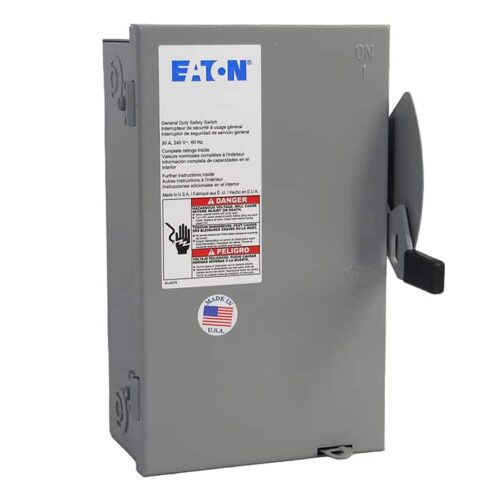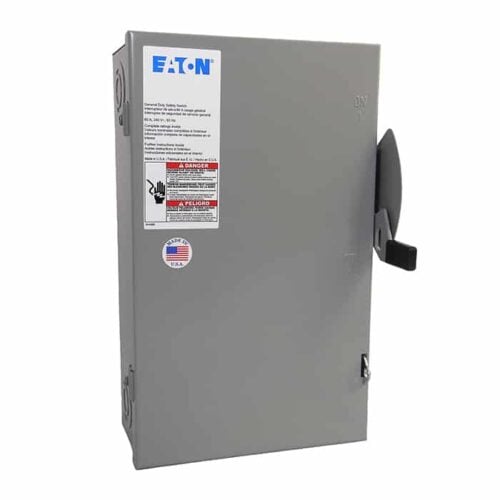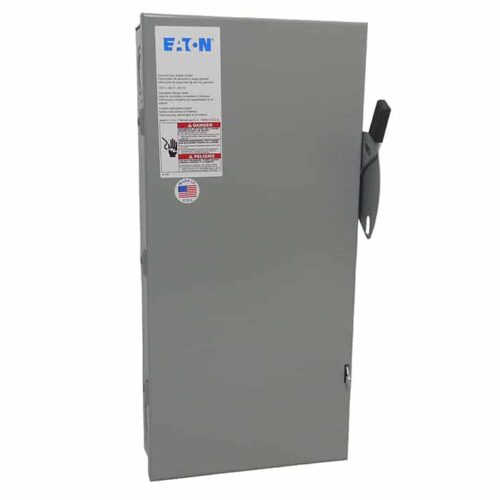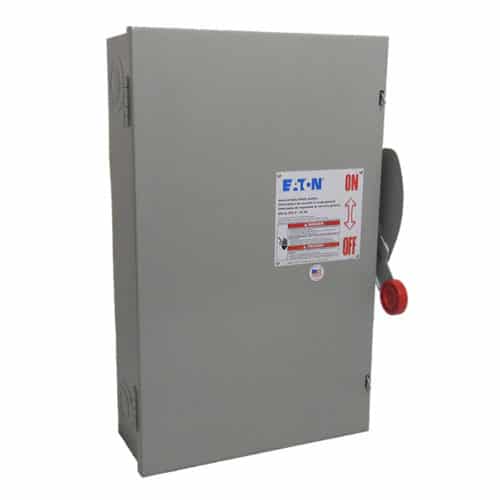A safety or disconnect switch is a simple electromechanical switch used to shut a motor or disconnect the power flow for various purposes. It disconnects electricity from its voltage source. This ensures safety when working on the machine or equipment for repair, maintenance, and so on. It is also used to shut down the system or machine in case of any malfunction or alert being issued. These manual safety switches are easy to use and a must in all industrial environments to ensure the safety of systems and personnel. North America Phase Converters offers a variety of electrical disconnect switches made by reputed manufacturers such as Eaton Corp. and more. If you plan to set up a new industrial unit or upgrade your existing one, we are a reliable disconnect switch supplier. Contact us today for any further information about the manual disconnect switches we offer.
Overview of Safety Switches and Disconnects
Electrical disconnect switches are essential in modern electrical systems and work as isolators by interrupting the flow of electric current. Once switched off, these switches safeguard users by cutting them from live voltage. Hence, they are a must in all industrial and commercial units. These switches are installed so they are visible from all the motors and equipment. Also, the switch must be installed within 50 feet of the equipment or machines it controls. It is also often used at the service entrance and the entry point of a building, which means it controls the power supply of the entire building.
At North America Phase Converters, we offer fusible and non-fusible safety switches in various amperages, ranging from 30 to 200 amperes and beyond. All these switches comply with the National Electric Code (NEC) established by the National Fire Protection Association (NFPA). We offer fusible and non-fusible switches.
Types of Safety Switches and Disconnects
At North America Phase Converter, you can choose the right safety disconnect switch from our selection of:
- Fusible safety switches: These switches have integrated fuse and hence are a safe option. They protect the circuit from shorting and overcurrent. This enables you to manually open and close the circuit in a protected manner. The fuses protect the equipment by interrupting the electrical flow in between. if an issue is detected, thus ensuring safety. However, fuses need to be replaced once they open. However, it is important to determine if you require a fusible switch. Generally, these are applicable in environments with a possibility of overcurrent and heavy power consumption, such as industrial motors, heavy machinery, HVAC systems, and so on. These switches are expensive and high-maintenance compared to non-fusible ones but reliable, especially for use in industrial units.
- Non-fusible safety switches: Non-fusible safety switches do not have a fuse integrated in them and hence do not offer protection when manually opening or closing the circuit. You can disconnect the switch manually in case of any issue or after use. You can use a circuit breaker to achieve overcurrent protection for non-fusible switches. They are suitable for general or domestic use, where shorting is not a frequent possibility. They are simple, cost-effective, and low on maintenance as there is no question of replacing a blown fuse.
Key Benefits of Safety Switches and Disconnects
Here are some key benefits of using our electrical safety switches.
- Electrical disconnect switches improve the safety of equipment and personnel, especially when performing repair, maintenance, and related activities.
- They prevent arc flashes during electrical work by isolating the power circuit.
- They prevent electrical overload, thus safeguarding equipment damage from surges.
- Disconnects help meet various compliance requirements such as those for NEC, OSHA, and other required standards, depending on the region.
- These switches have lockout/tagout (LOTO) features that are essential for compliance with industrial safety standards and workplace regulations. Lockable disconnect switches prevent accidental restarts during maintenance. In many ways, they ease the maintenance, power restoration, and troubleshooting processes.
- We offer outdoor and indoor disconnect switches, and ones specifically designed for hazardous applications.
Safety Switch Enclosure Ratings
A NEMA-compliant housing or enclosure is a must for all switches. The disconnect switches we offer are housed in NEMA enclosures with the following ratings depending on your application requirements.
- Type 1: These general-purpose enclosures are designed for indoor use. They help safeguard users by avoiding direct contact with the switch and protecting the disconnect switch from dirt, debris, moisture, contaminants, and so on.
- Type 3R: These enclosures are for outdoor use, and hence designed to resist rain, heat, and snow.
- Type 4/4X: These enclosures can be used both indoors and outdoors and designed to be resistant to all forms of precipitation. The 4X enclosure is specifically designed to be corrosion-resistant.
- Type 12: These enclosures are designed for indoor use with protection against dust, water, debris, and solid objects in the periphery.
Applications of Safety Switches
Disconnects are absolutely essential in industrial units, commercial buildings, power supply units of gated communities, and more. Here are some application areas of our safety switches and disconnects.
- Commercial buildings
- Healthcare
- Educational institutions
- Manufacturing industrial units
- Oil & gas
- Chemicals
- Water and wastewater treatment plants
Key Factors to Consider When Choosing Disconnect Switches
Here are some factors to consider when choosing disconnect switches, which will help you make an informed decision.
- Application requirements: The switch configurations and amperage will vary with requirements. So, identify if you need one for residential, commercial, or industrial requirements. Also check if the application involves exposure to moisture, chemicals, or heat. For this, you also need to check which enclosure types and amperage range is suitable.
- Environmental conditions or operating environment: There are different switches for indoor and outdoor applications. Even for indoor applications, identify the operating environment, such as if the industrial unit would have chemicals, corrosive elements, heavy objects, temperature extremes, and so on.
- Size: The size of the switch is an important aspect as it determines its electrical load capacity. For a better operational efficiency, install switches with both continuous and peak load requirements.
- Fuse or non-fuse requirements: Check your power consumption and nature of operation to decide if you require non-fusible or fuse disconnect switches. Determine the risk of overcurrent or shorting; if yes, choose fuse disconnect switches.
- Amperage requirements: Choose a switch that supports the expected current load. Also, check if the switch can handle the maximum voltage of the system.
- Enclosure rating: Choose a NEMA certified enclosure. Determine the type of enclosure material such as stainless steel or thermoplastic depending on your requirements such as exposure to corrosion, moisture, UV resistance and so on.
- Compliance: Ensure your chosen switch meets industry standards such as OSHA and NEC. Also, ensure the enclosure is NEMA certified. Also check for any compliance requirements based on local or regional industry standards.
FAQs
Can safety switches be used for renewable energy systems like solar panels or wind turbines?
Yes, safety switches can be used for solar panels and wind turbines. After assessing the risk, appropriate safety switches can be connected to a standard control system via a controller.
What’s the difference between a safety switch and a circuit breaker?
A safety switch isolates electric power when performing maintenance or repairs. A circuit breaker protects the wiring and electrical systems by tripping in case of faults.
How do I know what amperage rating is right for my application?
You can determine your amperage by calculating the total current draw of the concerned devices and the voltage as well. Calculate total amperage using a simple formula- Amp= Watts/Volts for all the devices. It must be less than 80% of the breaker’s total amperage.
How do I properly install a safety switch?
First, turn off the power. Identify the circuit and arrange the wires accordingly. Now install the safety switch and connect the wires. Test if the circuit functions normally. Label the switch appropriately and recheck everything before making it fully operational. You can seek professional help from an electrician or the concerned manufacturer.
Can a safety switch be repaired if it malfunctions?
It is best to call an electrician to identify why the switch is not working. Yes, you can either repair or replace a switch depending on the issue.
What codes or standards do safety switches need to comply with?
Safety switches must adhere to standards issued by NEC and OSHA. You also need to check region-specific requirements based on local regulatory bodies.
Are all your safety switches offered by North America Phase Converter Co. UL-listed?
Yes, all our safety switches are UL listed, which ensures safety from fire, and other hazards. UL-98 is the standard for Enclosed and Dead-Front Switches, which mentions the design and testing requirements for switches to be used as branch circuits, feeders, service, and motor circuits.
Can safety switches be customized for specific industrial applications?
Yes, safety switches can be customized based on specific industrial requirements. They can be specially designed for hazardous or corrosive environments.
What are the advantages of double-door safety switches over traditional designs?
Yes, double-door safety switches offer both safety and convenience. They separate the operational components from the wiring compartment, reducing the risk of arc flashes. Also, the LOTO feature in these switches is advanced and offers better safety than traditional switches.




